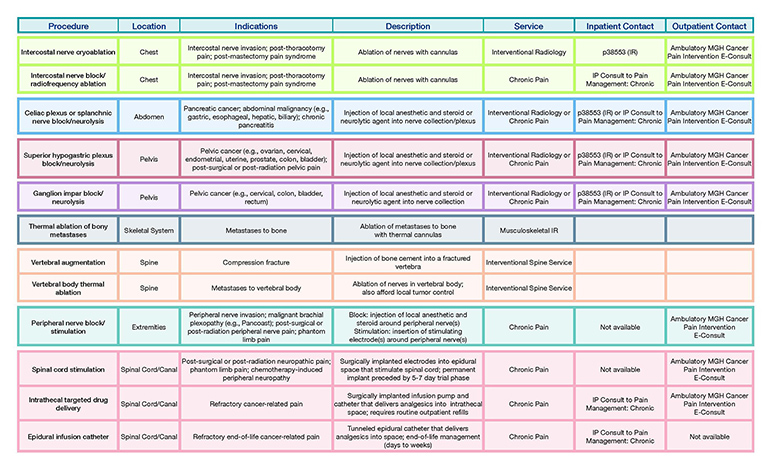A Visual Reference for Cancer-related Pain and Associated Treatments
In This Article
- The resources were designed to improve awareness of and accessibility to interventional pain management options for patients with cancer
- The resource highlights specific areas of the body where patients with cancer may experience related pain and interventional procedures that can be used to treat the pain
- The graphic and chart will be distributed to healthcare teams across Mass General Brigham
Patients with cancer can experience pain related to the cancer throughout the body.
Subscribe to the latest updates from Radiology Advances in Motion
To help clinicians address the pain, David Hao, MD, a physician in the Department of Anesthesia, Critical Care, and Pain Medicine at Mass General Brigham (MGB), and Thomas J. An, MD, a physician in the Department of Radiology, collaborated with MGB illustrator and medical photographer Susanne Loomis to develop a graphic and a chart outlining the different types of pain and the associated treatments.
In the Q&A below, Dr. Hao describes the new resource and how it can advance clinical care.
Q: What information is included in the graphic and the chart?
Hao: The graphic provides a visual representation of the human body, highlighting specific areas where interventional procedures can be applied to manage cancer-related pain. The chart lists various interventional treatments, including nerve blocks, cryoablation, and spinal procedures. Each procedure is categorized by location in the body (e.g., chest, abdomen, pelvis, spine) and includes details such as the relevant indications, a brief description, and how to access the service (both inpatient and outpatient).

Figure 1
Graphic: Interventional procedures for cancer-related pain.
Q: What led you to create this resource?
Hao: This was developed to address a need for improved accessibility and awareness of interventional pain management options for cancer patients. Cancer-related pain can be complex and involves multiple structures; many patients and clinicians may not be aware of all the available interventions or the appropriate pathways for care. By creating this resource, the goal is to streamline decision-making and make it easier for clinicians and patients to explore pain management options, improving both care coordination and access to specialized pain treatments.
Q: How will you implement the graphic and the chart?
Hao: The graphic and chart will be distributed both in print and digital formats to healthcare teams, including oncologists, palliative care specialists, and pain management teams in both inpatient and outpatient settings.

Figure 2
Chart: Interventional procedures for cancer-related pain.
Q: In what ways can the ready availability of the information impact care?
Hao: Ready access to this information can significantly impact patient care by expediting referrals to appropriate interventional treatments. For instance, areas like intercostal nerve blocks, celiac plexus neurolysis, and intrathecal drug delivery may see increased utilization, especially for complex cases of cancer pain that might otherwise go untreated or be inadequately managed. Ultimately, having clear pathways outlined helps ensure timely interventions, reduces patient suffering, and enhances quality of life for those with cancer-related pain.